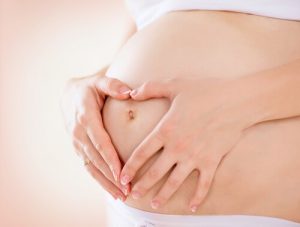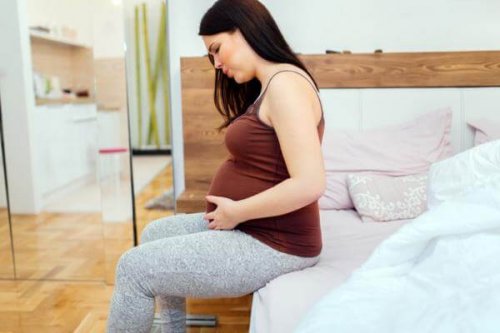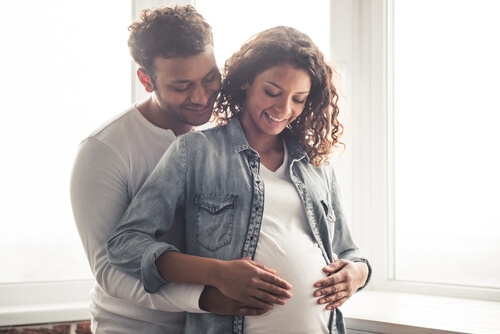Do The Baby’s Kicks Hurt?

Not all of the baby’s kicks during pregnancy hurt, however, a few of them do. It mostly depends on the strength of their movement and a few additional factors.
The most important thing is for the future mother to have the right information.
A baby’s kicks have the power to fascinate both the future parents and the rest of the family. Whenever a family member or friend becomes pregnant, the first thing others do is touch their belly to feel the sensation.
The question is, are these movements painful for the mother?
It’s all relative. Not all kicks hurt, but there are some that do. It all depends on the strength of the movement and a few other factors that have to be taken into consideration.
Movements starting from the 22nd week
Women usually begin to perceive fetal movements after the 22nd week. During this moment of gestation, mothers may only feel slight friction or mild contact.
This occurs since the fetus is still so small. It has room to move freely around the uterus.
After a month and a half, women will continue to feel kicks that shouldn’t be very bothersome. Afterwards the pressure and the baby’s kicks will increase in strength and regularity.
The mother is basically feeling the fetus colliding with the walls of the uterus while it’s changing positions.
As the baby continues to develop, the space they have to move is reduced and this may cause a change in sensations.

The baby’s kicks may hurt after the 28th week
During the 28th week, the baby continues to grow while the size of the uterus has practically reached its limits. This is when slight movements may begin to hurt.
Their kicks may hurt because the child comes into contact with the walls more frequently. In addition, the child has now developed more physical strength.
The little one may feel uncomfortable and active and this can sometimes cause pain for the mother. The impact of the kicks can be felt around the woman’s ribs and other organs.
Some of the kicks can even cause a loss of breath or awaken a sleeping pregnant woman. There is great variety when it comes to the intensity of the baby’s movement.
Nights are the period with the most kicks
It has been proven that babies are more active during the night. Between nine in the evening and midnight their physical activity increases. This may be a result of (among many other things) food intake.
Mothers should watch their diet. Some products such as those that contain sugar can stimulate the fetus even in the uterus. That’s why it’s best to reduce your intake of sugar during dinner.
If you have any concerns, don’t hesitate to contact your gynecologist and ask them about the proper diet for you to follow.
Night time is ideal for counting the baby’s movement. This is an activity that many gynecologists advise in order to identify the baby’s health status.
The purpose of keeping track of the movements is to understand their frequency. This way the future mother will be able to prepare herself to face the impacts.
Circumstances which cause the baby’s kicks to hurt more
Every pregnancy has unique characteristics and in that sense it’s understandable that not all kicks are felt in the same way.
For example, first-time mothers may experience these kicks with increased sensitivity. This may occur since the movements might take them by surprise.
If the mother is skinny, the baby’s kicks may be felt more intensely. In these cases, the fetus can easily impact the ribs and lower belly. The baby’s weight is another important factor to consider.

In addition, during the pregnancy of twins or triplets, the kicks may be more painful. The reduction in space may be uncomfortable for the future neonates.
In these cases, the kicks may occur more frequently and the mother may suffer from very annoying pains.
Some recommendations for first-time mothers
The best indicator for a child’s well-being is the frequency of their movements. It is even more worrying when the child doesn’t move around for long periods of time.
It is always advisable to discuss your pain problems with your gynecologist. Symptoms that you find worrying should always be evaluated by a specialist.
Breathing, waking and stimulating the baby with music are all recommended practices. Yoga for pregnant women has also been seen to reduce the discomfort of the fetus’s kicks and movements.
The good news is that the intense pain only occurs during the last weeks of pregnancy.
All cited sources were thoroughly reviewed by our team to ensure their quality, reliability, currency, and validity. The bibliography of this article was considered reliable and of academic or scientific accuracy.
- Stanford Medicine Children’s Health. (s. f.). Conteo de movimientos fetales. Consultado el 14 de mayo 2023. https://www.stanfordchildrens.org/es/topic/default?id=fetalmovementcounting-90-P05559
- Clínic Barcelona Hospital Universitari. (s.f.). PROTOCOLO: DISMINUCIÓN DE LOS MOVIMIENTOS FETALES. Universidad de Barcelona. 1-11. Consultado el 14 de mayo 2023. https://portal.medicinafetalbarcelona.org/protocolos/es/patologia-fetal/disminucion%20movimientos%20fetales.pdf
- Cunningham F, & Leveno K.J., & Bloom S.L., & Dashe J.S., & Hoffman B.L., & Casey B.M., & Spong C.Y.(Eds.). (2019). Capítulo 17: Evaluación fetal. Williams Obstetricia, 25e. McGraw Hill. Consultado el 14 de mayo 2023. https://accessmedicina.mhmedical.com/content.aspx?bookid=2739§ionid=229283549
- Gonzales Espejo, B. (2016). Conocimientos, actitudes y prácticas sobre signos y síntomas de alarma en gestantes atendidas en la unidad de alto riesgo obstétrico del Hospital Nacional Guillermo Almenara Irigoyen. Universidad Ricardo Palma. https://repositorio.urp.edu.pe/handle/20.500.14138/521
- Félix Santamaría, C. (2015). LOS MOVIMIENTOS FETALES COMO MARCADOR DE BIENESTAR FETAL. Servicio de Obstetricia y Ginecología, Hospital Universitario Virgen de las Nieves Granada. 1-19. https://www.huvn.es/archivos/cms/ginecologia-y-obstetricia/archivos/publico/clases_residentes/2015/clase2015_movimientos_fetales.pdf
- Copel, J. A., & Bahtiyar, M. O. (2014). A practical approach to fetal growth restriction. Obstetrics and gynecology, 123(5), 1057–1069. https://journals.lww.com/greenjournal/Documents/May2014_Translation_Copel.pdf
- Matos, T. (2015). Cuidados del Embarazo: Maternidad y Salud. Maternidad y Salud. https://books.google.es/books?id=oPa1BgAAQBAJ&dq=patadas+del+beb%C3%A9+COSTILLAS&lr=&hl=es&source=gbs_navlinks_s
- Corradine Velásquez, E. (2016). Diseño de un protocolo para el análisis del movimiento fetal ante estímulos sonoros. Uniandes. https://repositorio.uniandes.edu.co/handle/1992/18662
- Mejia Mendoza, P. H., & Arotoma Ore, M. I. (2017). Conocimientos y actitudes sobre señales de alarma durante el embarazo – Hospital Carlos Lanfranco la Hoz – Lima 2016. Universidad Nacional Santiago Antúnez de Mayolo. http://repositorio.unasam.edu.pe/handle/UNASAM/1919
This text is provided for informational purposes only and does not replace consultation with a professional. If in doubt, consult your specialist.
